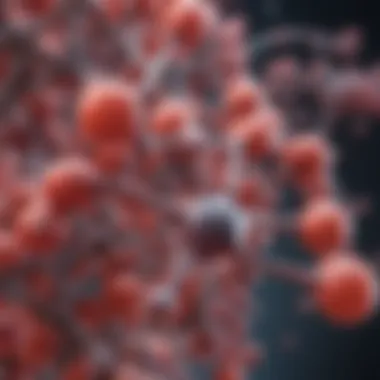Allantoin Gel for Scars: Efficacy and Applications


Intro
In the quest for effective scar treatment, allantoin gel stands out as a noteworthy option. This article aims to dissect the various aspects of allantoin gel, focusing on its efficacy, safety, and mechanisms of action. Understanding how this compound works is crucial for both practitioners and patients seeking viable options for scar management.
The molecular composition of allantoin lends it unique properties that assist in skin repair and healing. As we delve deeper into this topic, it is imperative to grasp the key concepts and terminology associated with allantoin gel, so that we can appreciate its relevance in contemporary dermatological practices.
Key Concepts and Terminology
Definition of Key Terms
- Allantoin: A naturally occurring compound found in various plants and some animals, known for its soothing, moisturizing, and healing properties.
- Gel: A semi-solid substance used to deliver active ingredients directly to the skin’s surface.
- Scar: A mark left on the skin after a wound has healed, which may differ in color or texture from the surrounding area.
Concepts Explored in the Article
This article will cover several key concepts:
- The molecular mechanisms by which allantoin promotes skin healing.
- Clinical studies and evaluations regarding its efficacy compared to other treatments for scars.
- Applications in dermatology, including various forms of scar treatment.
- A discussion on safety profiles, side effects, and recommendations for optimal use.
Findings and Discussion
Main Findings
Research indicates that allantoin has several beneficial effects on scar treatment. It is thought to enhance wound healing by stimulating cell proliferation and promoting hydration. Clinical trials have showcased its potential in reducing the appearance of scars while having a favorable safety profile, making it attractive for use in diverse populations.
Allantoin aims to not just treat existing scars but to aid in the prevention of further scarring during the healing process.
Patient experiences vary, and some report noticeably improved skin texture and tone over time with consistent use of allantoin gel.
Potential Areas for Future Research
Despite existing studies, there remains room for further exploration. Future research can focus on:
- Long-term effects of allantoin gel on scar maturation.
- Combination treatments that include allantoin with other compounds.
- Its effectiveness in different types of scars, such as hypertrophic or keloid scars.
A deeper understanding may strengthen the case for allantoin gel as a primary treatment modality in scar management, benefiting a wide array of patients.
Prelims to Allantoin Gel
The significance of allantoin gel in dermatology cannot be overstated. This compound has garnered attention for its potential role in scar management. Scars can be a source of anxiety and distress for many individuals, exacerbating self-esteem issues. Understanding how allantoin gel functions can provide insight into its therapeutic potential.
Allantoin is recognized for its ability to promote skin healing. This is particularly important in cases where the skin has been compromised due to injury, surgery, or other forms of trauma. Its effectiveness in enhancing cell growth and facilitating tissue repair sets it apart from many other topical agents. This article will delve into the various aspects of allantoin gel, including its mechanisms of action, clinical efficacy, and practical applications. The exploration of these elements will assist healthcare providers and patients alike in making informed decisions regarding scar treatment.
What is Allantoin?
Allantoin is a naturally occurring compound found in several plants, including comfrey and the seeds of the horse chestnut. It’s also present in the root of the tobacco plant. Chemically, it is a urea derivative and belongs to a class of compounds known as diureides. This structure gives allantoin its unique properties, contributing to its suitability in skin care products.
Primarily known for its moisturizing effects, allantoin helps to soothe and protect the skin. It promotes cell proliferation, which is contributing to its healing attributes. It can penetrate the skin barrier and enhance hydration levels. This mechanism is valuable in environments where skin integrity is compromised, such as in scars. Furthermore, allantoin is often included in a variety of formulations ranging from creams and ointments to gels.
Historical Overview of Allantoin in Medicine
Historically, allantoin has been used in traditional medicine for various purposes. Its use can be traced back to ancient Greece, where it was applied in the treatment of wounds and skin irritations. The therapeutic attributes of allantoin were noted in herbal texts, emphasizing its protective properties.


In the modern era, allantoin began to gain recognition in dermatology during the mid-20th century. It was integrated into many topical formulations aimed at enhancing skin repair. Over the decades, numerous studies have investigated its effectiveness in promoting wound healing and reducing scar formation. Due to the favorable outcomes observed in clinical settings, allantoin has been widely accepted as a valuable ingredient in dermatological products. Its safety profile also makes it a suitable option for various populations, including individuals with sensitive skin.
In summary, the exploration of allantoin gel for scar treatment reveals its historical significance and molecular attributes. By understanding both its background and its current applications in dermatology, we can better appreciate the role of allantoin in scar management.
Understanding Scars
Scars are an integral part of the skin's healing process after an injury. They emerge when the skin undergoes trauma, whether from cuts, burns, or surgical procedures. Understanding how scars form is crucial for identifying effective treatment methods, particularly the role of various topical agents such as allantoin gel in their management. This section explores types of scars and the intricate healing process of the skin, drawing a comprehensive picture of how scars impact both physical appearance and emotional well-being.
Types of Scars
Scars can be classified into several types, each with distinct characteristics. The common types include:
- Atrophic Scars: These scars are typically flat and may appear recessed compared to surrounding skin. They often result from conditions like acne or chickenpox.
- Hypertrophic Scars: These are raised scars that stay within the boundaries of the original wound. Their formation is a response to excess collagen during the healing process.
- Keloid Scars: Keloids extend beyond the original injury site and can grow significantly larger. They occur due to an overproduction of collagen.
- Contracture Scars: Often a result of burns, contracture scars tighten the skin, potentially limiting movement.
Understanding these types is vital for effective scar management. Each type may respond differently to treatments such as allantoin gel, which may help improve the appearance of atrophic scars, while hypertrophic and keloid types might require different approaches.
The Healing Process of the Skin
The skin's healing process is a multifaceted journey that can be divided into several phases: hemostasis, inflammation, proliferation, and remodeling. Each phase plays a critical role in how scars are formed and how they can potentially be treated:
- Hemostasis: This initial phase starts immediately after an injury. Blood vessels constrict to stop bleeding, followed by clot formation, which acts as a temporary barrier against infection.
- Inflammation: The body responds to injury with an inflammatory reaction. White blood cells and growth factors work to clean the wound. This phase can last several days and is crucial for preparing the wound for healing.
- Proliferation: During this phase, the body begins to rebuild tissue. New blood vessels form, and collagen synthesis is ramped up. Allantoin gel may play a role in promoting cell proliferation, enhancing tissue regeneration during this critical phase.
- Remodeling: This final phase can take months to years. The newly formed tissue gradually gains strength and flexibility, often becoming a scar. The collagen fibers that form can lead to either flat or raised scars, depending on regulatory signals.
Understanding these phases provides insights into how external treatments can influence scar formation and healing efficiency. Allantoin's mechanisms may help during the proliferation phase, potentially leading to better cosmetic outcomes for individuals with varying scar types.
Mechanisms of Action of Allantoin
The mechanisms through which allantoin exerts its benefits in skin care are critical in understanding its role in scar treatment. Allantoin is known for its unique properties that support skin healing and regeneration. By enhancing several physiological processes, allantoin aids in minimizing the appearance of scars. This section delves into the specific ways allantoin functions within the skin, highlighting its effects on cellular activity, hydration, and inflammation.
Cell Proliferation and Tissue Regeneration
Cell proliferation is a fundamental factor in the healing of wounds and the formation of new tissue. Allantoin has shown significant potential in stimulating the growth of new cells. This occurs through several biological pathways. Firstly, allantoin promotes keratinocyte migration and proliferation, leading to enhanced re-epithelialization. By encouraging these skin cells to grow, allantoin helps to repair damaged tissues more effectively.
Additionally, studies suggest that allantoin increases collagen synthesis. Collagen is an essential protein that provides structure and stability to the skin. Adequate levels of collagen can reduce the visibility of scars and support a more uniform skin texture. The regenerative properties of allantoin make it an important component in scar treatment protocols.
Hydration and Skin Barrier Function
Proper hydration of the skin is essential for effective healing. Allantoin acts as a humectant, which means it draws moisture from the environment into the skin. This enhances the moisture content of the stratum corneum, the outermost layer of the skin, making it more elastic and less prone to damage. Adequate hydration also aids in reducing the appearance of scars by keeping the skin supple.
Moreover, allantoin strengthens the skin barrier function. When the skin barrier is intact, it protects against environmental stressors and prevents transepidermal water loss. A strengthened barrier aids in preventing further irritation and enhances the overall health of the skin. Thus, the hydration capability of allantoin is crucial in scar management, providing both immediate and long-term benefits.
Anti-Inflammatory Properties
Inflammation plays a significant role in the formation of scars. Excessive inflammation can lead to hyperpigmentation and the development of thick, raised scars. Allantoin possesses anti-inflammatory properties, which help to mitigate these effects.
It inhibits the production of pro-inflammatory cytokines, effectively reducing redness and swelling in the affected area. This anti-inflammatory activity not only aids in improving the appearance of existing scars but also prevents the formation of new scars during the healing process. By keeping inflammation in check, allantoin promotes a healthier and more balanced healing environment.
Allantoin is a multi-faceted compound that supports skin healing through cell proliferation, hydration, and anti-inflammatory properties.
The mechanisms of action elucidated above underscore the significance of allantoin in dermatological applications, especially for scar management. Understanding these processes allows professionals and researchers to utilize allantoin more effectively in clinical settings.
Clinical Efficacy of Allantoin Gel
The clinical efficacy of allantoin gel plays a crucial role in evaluating its applicability in scar treatment. By understanding how well this compound works, healthcare professionals can better guide patients seeking effective solutions for scar management. This section highlights several vital aspects, such as the mechanisms by which allantoin influences healing, the evidence from various studies regarding scar reduction, and the comparative effectiveness of this treatment against traditional therapies.


Studies on Scar Reduction
Several clinical studies have investigated the effectiveness of allantoin gel in reducing scars. One notable research examined its use in post-surgical patients. In this study, the participants applied allantoin gel to incisions after surgery. Results indicated a significant reduction in scar visibility over time when compared to a control group using a placebo. The participants reported enhanced satisfaction with their healing process, suggesting that allantoin plays a positive role in improving skin appearance post-surgery.
Additionally, other studies focused on acne scars. One such trial involved patients with various degrees of acne scarring who used allantoin gel for eight weeks. The findings demonstrated that a majority of participants experienced marked improvements in scar texture and color. These studies provide strong evidence of allantoin's potential to aid in scar management.
Comparative Analysis with Other Treatments
While the studies show encouraging results for allantoin gel, it is essential to compare its clinical efficacy with that of other established treatments. Some common alternatives include silicone gel products, corticosteroids, and laser therapies. For instance, silicone gel sheeting has long been a standard in scar management. However, studies suggest that allantoin gel may offer comparable results, with an additional benefit of being easier to apply.
Also, when considering cost and accessibility, allantoin gel stands out as a more affordable option for many patients. In contrast, laser treatments often require multiple sessions and can be financially burdensome.
The following points summarize the key considerations in the comparative analysis:
- Efficacy: Clinical data suggest allantoin gel effectively reduces scar visibility, similar to silicone and corticosteroids.
- Cost-Effective: Allantoin is generally cheaper and more accessible than laser treatments.
- Ease of Use: Allantoin gel's application is simple and does not require specialized equipment.
"The clinical efficacy of allantoin gel, particularly in scar treatment, opens new avenues for managing skin health with minimal side effects and accessibility."
Applications in Dermatology
Allantoin gel exhibits significant relevance in dermatology, particularly in the management of scars. Its properties make it a key ingredient in skin care formulations aimed at promoting healing. Medical professionals often seek effective treatments for different scar types, and allantoin emerges as a proven option. It is important to discuss how allantoin gel is applied in various clinical scenarios to support optimal healing outcomes.
Post-Surgical Scar Management
Post-surgical scars can be a concern for many patients. After surgery, the skin needs proper care to ensure healing and minimize scar formation. Allantoin gel helps maintain skin hydration and supports cellular regeneration. This can lead to less prominent scars.
- Hydration: Allantoin acts as a humectant, attracting moisture to the skin. This helps keep the scarred area supple, preventing crusting or dryness.
- Regeneration: By promoting new skin cell growth, allantoin can facilitate healing. This regeneration process can reduce the time taken for scars to fade.
- Skin Barrier Integrity: Allantoin supports skin barrier function, which is essential for preventing infections at surgical sites.
By applying allantoin gel after surgical interventions, healthcare providers can enhance the overall outcomes of scar management. Patients are often advised to start using the gel once sutures are removed, following their doctor's guidance.
Incorporation in Cosmetic Procedures
In cosmetic dermatology, allantoin gel is increasingly being included in procedures that aim to improve skin texture and appearance. From laser treatments to chemical peels, allantoin can be beneficial in managing post-procedure healing. Consider the following aspects:
- Soothing Sensation: Allantoin has calming properties, which can alleviate discomfort experienced after treatments.
- Enhanced Recovery: Its ability to speed up cell turnover contributes to faster recovery times. Procedural downtime can be significantly reduced.
- Compatibility: Allantoin can be safely combined with other active ingredients, making it versatile in many cosmetic formulations.
The integration of allantoin gel into post-cosmetic procedure care provides added value. It not only enhances healing but also improves patient satisfaction with the results of their treatments.
"The use of allantoin in dermatological practices exemplifies its versatility and efficacy in promoting skin health and healing."
Safety and Side Effects
The safety and side effects of allantoin gel are paramount in determining its viability as a treatment for scars. Understanding these aspects ensures that users can make informed decisions regarding their skin care regimen. Allantoin, recognized for its skin healing properties, is generally perceived as safe. However, like any topical agent, it may carry potential risks. This section delves into common side effects that users might experience and outlines specific contraindications and precautions necessary for safeguarding skin health as well as overall safety.
Common Side Effects
Although allantoin gel is well-tolerated by many individuals, some may experience mild side effects. These include:
- Irritation: Some people report skin irritation, which may manifest as redness or discomfort upon application.
- Dryness: In certain cases, excessive use might lead to dryness of the skin.
- Rash: A few users can develop a rash, indicating a potential sensitivity to the compound.
It is important to note that these side effects are typically mild and often resolve shortly after discontinuation or adjustment in usage. As a precaution, individuals who have sensitive skin or are prone to allergic reactions should conduct a patch test prior to full application. Applying a small amount of allantoin gel on a discreet area can help check for adverse reactions.


Contraindications and Precautions
While allantoin is generally safe, there are some contraindications and precautions to consider:
- Existing Allergies: Individuals with known allergies to allantoin or any of its components should avoid its use.
- Wounded Skin: It is not advisable to apply allantoin on open wounds or lesions, as this could exacerbate irritation and delay healing.
- Pregnancy and Breastfeeding: Pregnant and nursing women should consult a healthcare provider before use, as limited studies exist on the long-term effects in these populations.
- Concurrent Medications: Those who use other topical treatments should seek medical advice to prevent potential interactions.
Guidelines for Optimal Use
In the context of allantoin gel, adhering to established guidelines for optimal use is essential. These guidelines ensure maximum efficacy and safety when employing this treatment for scars. They encompass various factors, including application techniques and frequency of use, both of which can significantly influence the outcome of scar management.
Understanding the right methods for applying allantoin gel is key. Many users may underestimate the impact of technique. The consistency and manner of application can either enhance healing or lead to suboptimal results. Moreover, frequency of use can alter how the skin responds to the therapy. Increased frequency does not always correlate with refined results. Instead, a balanced approach is often superior.
"Proper application and timing play critical roles in optimizing the effects of allantoin gel in scar treatment."
It is also vital to consider individual skin types and conditions, as these factors can affect response to the gel. Guidelines can help individuals tailor their approach, leading to more personalized and effective scar management. Now, let’s explore in detail the application techniques and frequency of use necessary for optimal results.
Application Techniques
Proper application techniques are crucial for maximizing the benefits of allantoin gel.
- Clean the Area: Before applying the gel, clean the targeted area with mild soap and water. This minimizes the risk of infections and prepares the skin for treatment.
- Pat Dry: After cleaning, gently pat the area dry with a soft towel. Avoid rubbing, as this can irritate the skin.
- Apply a Thin Layer: Squeeze a small amount of allantoin gel onto your fingertip and spread a thin layer over the scar. It should evenly cover the area but not form a thick layer.
- Gentle Massage: Use your fingertips to gently massage the gel into the skin. This can increase absorption and enhance the therapeutic effect without causing discomfort.
- Monitor for Reactions: Post-application, observe the skin for any signs of irritation or adverse reactions. If redness or discomfort occurs, it may be wise to limit use and consult a dermatologist.
By following these steps, users can optimize the benefits of allantoin gel and support scar healing effectively.
Frequency of Use
Frequency of use is another critical factor in achieving desired outcomes with allantoin gel. Optimal frequency may vary based on individual skin response and the nature of the scars being treated.
- Initial Phases: Often, a common recommendation involves applying the gel two to three times daily. This consistency helps maintain hydration and promotes cell regeneration.
- Monitoring Progress: Users should monitor how their skin reacts. If improvement is noted, it may be appropriate to adjust the frequency to once or twice daily as the skin improves. Conversely, if irritation arises, reduce the frequency.
- Long-Term Use: For long-term scar management, consistency is crucial, but it does not necessitate continuous daily use. Some may find it beneficial to use the gel for several weeks, then take a break before repeating the process.
Finding a balance in frequency is essential. It ensures that the skin remains receptive to treatment while minimizing the likelihood of adverse effects.
Future Research Directions
Research into allantoin gel's efficacy and applications is still evolving. Future directions are essential to fully understand its potential in dermatology and beyond. The importance of this topic lies not only in enhancing scar treatment but also in discovering novel therapeutic avenues. Advancements in formulation techniques can lead to more effective products, potentially increasing patient satisfaction and adherence to treatments.
Exploring New Formulations
The exploration of new formulations of allantoin gel is crucial. Current formulations may have limitations in terms of absorption and stability. Researchers can investigate different bases, such as emulsion or gel systems, that can enhance allantoin’s penetration into the skin. Formulating allantoin with liposomes or nanoparticles might increase bioavailability. These methods could potentially lead to more efficient scar management. Future studies should also focus on incorporating allantoin in topical drug delivery systems. This can optimize its efficacy in addressing various types of scars.
Potential Synergies with Other Ingredients
Combining allantoin with other active ingredients holds promise. Such partnerships can enhance the overall healing process. For example, combining allantoin with silicone can improve hydration and protect the scar area. Adding antioxidants may also bolster skin health by fighting oxidative stress. Research into these combinations could highlight the importance of synergistic effects. By understanding how different ingredients interact, scientists can create innovative products that leverage the strengths of each component. This could lead to improved outcomes in scar treatment and patient care.
"New formulations and ingredient synergies could redefine the scope of allantoin gel in scar management, paving the way for better treatments."
The End
The conclusion serves as a crucial synthesis of the entire discussion on allantoin gel and its role in managing scars. By summarizing the findings and insights presented throughout the article, readers can appreciate the multifaceted nature of allantoin in dermatological applications. This section encapsulates the significance of allantoin gel in the context of skin healing and scar treatment, reinforcing its potential benefits and key considerations for various populations.
One of the primary realizations from this exploration is that allantoin gel is not just a topical treatment; it operates at the molecular level to facilitate skin regeneration. Its mechanisms of action include promoting cell proliferation and enhancing hydration, which are fundamental for effective healing processes. The implications for patients with various scar types—be it post-surgical, hypertrophic, or keloid—are particularly noteworthy, as they highlight allantoin’s versatility as a treatment option.
Safety remains a significant aspect as well. Although allantoin gel exhibits a favorable safety profile, being aware of common side effects and precautions is essential for optimal usage. Furthermore, the analysis of clinical studies suggests that while allantoin is effective, there is merit in comparing it with other treatments to establish best practices for application.
Overall, the importance of this topic lies in its relevance to ongoing discussions in dermatology and scar management. As further research continues to unfold, the integration of allantoin gel into treatment protocols could lead to improved patient outcomes and innovations in scar therapy.
Summary of Key Points
- Molecular Mechanisms: Allantoin enhances skin healing through cellular proliferation and hydration.
- Clinical Efficacy: Numerous studies support its effectiveness in scar reduction, emphasizing its role in dermatological care.
- Applications: Suitable for post-surgical care and cosmetic purposes, showing versatility in its use.
- Safety and Side Effects: Generally well-tolerated, but awareness of any side effects is necessary.
- Future Research: Potential synergies with other ingredients offer opportunities for improved formulations and effectiveness.







